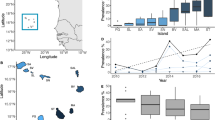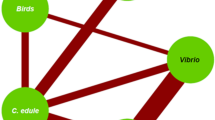Abstract
Sardine populations worldwide can fluctuate drastically over short time periods, in terms of both biomass and biological characteristics. Fluctuations might be amplified by pathogens, but such hypotheses have never been considered in the absence of clear macroscopic symptoms. In the Gulf of Lions (NW Mediterranean), an enduring severe decrease in sardine (Sardina pilchardus) size, condition and age has been observed since 2008, resulting in a strong decline in landings. This situation might have been caused or aggravated by diseases, especially as other drivers such as fisheries are not expected to be important. Therefore, we developed and performed a general veterinary study, aimed at detecting a wide range of potential pathogens, including parasites, viruses and bacteria. We explored which infectious agents are most likely to produce a causal relationship with sardine health, important information for future infection experiments. Among about 1300 sardines sampled during June 2014–July 2015, microscopic parasites (often trematodes and coccidians) and bacteria Tenacibaculum and Vibrio spp. were found. However, no clear damage to tissue was observed and there was generally no link between the agents’ presence and host size or condition, so that no strong indications of pathogenicity were present. Nonetheless, 54 % of the sardines analysed in 2015 had elevated quantities of melano-macrophage centres (macrophage aggregates), indicating stress on the fish that might potentially be related to starvation and/or pollution.


Similar content being viewed by others
References
Abollo E, Calvo M, Pascual S (2001) Hepatic coccidiosis of the blue whiting, Micromesistius poutassou (Risso), and horse mackerel, Trachurus trachurus (L.), from Galician waters. J Fish Dis 24:335–343. doi:10.1046/j.1365-2761.2001.00298.x
Agius C (1979) The role of melano-macrophage centres in iron storage in normal and diseased fish. J Fish Dis 2:337–343. doi:10.1111/j.1365-2761.1979.tb00175.x
Agius C, Roberts RJ (1981) Effects of starvation on the melano-macrophage centres of fish. J Fish Biol 19:161–169. doi:10.1111/j.1095-8649.1981.tb05820.x
Agius C, Roberts RJ (2003) Melano-macrophage centres and their role in fish pathology. J Fish Dis 26:499–509
Arnold TW (2010) Uninformative parameters and model selection using Akaike’s information criterion. J Wildl Manag 74:1175–1178. doi:10.1111/j.1937-2817.2010.tb01236.x
Bakke TA, Harris PD (1998) Diseases and parasites in wild Atlantic salmon (Salmo salar) populations. Can J Fish Aquat Sci 55:247–266. doi:10.1139/cjfas-55-S1-247
Baldwin RE, Banks MA, Jacobson KC (2011) Integrating fish and parasite data as a holistic solution for identifying the elusive stock structure of Pacific sardines (Sardinops sagax). Rev Fish Biol Fish 22:137–156. doi:10.1007/s11160-011-9227-5
Balebona MC, Zorrilla I, Moriñigo MA, Borrego JJ (1998) Survey of bacterial pathologies affecting farmed gilt-head sea bream (Sparus aurata L.) in southwestern Spain from 1990 to 1996. Aquaculture 166:19–35. doi:10.1016/S0044-8486(98)00282-8
Bates D, Maechler M, Bolker B, Walker S (2014) lme4: Linear mixed-effects models using Eigen and S4. R package version 1.1-10. http://CRAN.Rproject.org/package=lme4
Baud M, Cabon J, Salomoni A et al (2015) First generic one step real-time Taqman RT-PCR targeting the RNA1 of betanodaviruses. J Virol Methods 211:1–7. doi:10.1016/j.jviromet.2014.09.016
Baumgartner TR, Soutar A, Ferreira-Bartrina V (1992) Reconstruction of the history of Pacific sardine and northern anchovy populations over the past two millennia from sediments of the Santa Barbara Basin, California. CalCOFI Rep 33:24–40
Brosset P, Fromentin J-M, Ménard F et al (2014) Measurement and analysis of small pelagic fish condition: a suitable method for rapid evaluation in the field. J Exp Mar Biol Ecol 462:90–97. doi:10.1016/j.jembe.2014.10.016
Brosset P, Ménard F, Fromentin J-M et al (2015) Influence of environmental variability and age on the body condition of small pelagic fish in the Gulf of Lions. Mar Ecol Prog Ser 529:219–231. doi:10.3354/meps11275
Brosset P, Le Bourg B, Costalago D et al (2016) Linking small pelagic dietary shifts with ecosystem changes in the Gulf of Lions. Mar Ecol Prog Ser 554:157–171. doi:10.3354/meps11796
Brown CL, George CT (1985) Age-dependent accumulation of macrophage aggregates in the yellow perch Perca flavescens (Mitchell). J Fish Dis 8:135–138
Carli A, Pane L, Casareto L et al (1993) Occurrence of Vibrio alginolyticus in Ligurian coast rock pools (Tyrrhenian Sea, Italy) and its association with the copepod Tigriopus fulvus (Fisher 1860). Appl Environ Microbiol 59:1960–1962
Cavallero S, Magnabosco C, Civettini M et al (2015) Survey of Anisakis sp and Hysterothylacium sp in sardines and anchovies from the North Adriatic Sea. Int J Food Microbiol 200:18–21. doi:10.1016/j.ijfoodmicro.2015.01.017
Checkley D, Alheit J, Oozeki Y, Roy C (2009) Climate change and small pelagic fish. Cambridge University Press, New York
Colorni A, Paperna I, Gordin H (1981) Bacterial infections in gilt-head sea bream Sparus aurata cultured at Elat. Aquaculture 23:257–267. doi:10.1016/0044-8486(81)90019-3
Costa G, MacKenzie K (1994) Histopathology of Goussia clupearum (Protozoa: Apicomplexa: Coccidia) in some marine fish from Scottish waters. Dis Aquat Organ 18:192–202
Crockford M, Jones JB, McColl K, Whittington RJ (2008) Comparison of three molecular methods for the detection of pilchard herpesvirus in archived paraffin-embedded tissue and frozen tissue. Dis Aquat Organ 82:37–44. doi:10.3354/dao01965
Cury P, Bakun A, Crawford RJM et al (2000) Small pelagics in upwelling systems: patterns of interaction and structural changes in “wasp-waist” ecosystems. ICES J Mar Sci 57:603–618. doi:10.1006/jmsc.2000.0712
Elotmani F, Assobhei O (2004) In vitro inhibition of microbial flora of fish by nisin and lactoperoxidase system. Lett Appl Microbiol 38:60–65. doi:10.1046/j.1472-765X.2003.01441.x
Faílde LD, Losada AP, Bermúdez R et al (2013) Tenacibaculum maritimum infection: pathology and immunohistochemistry in experimentally challenged turbot (Psetta maxima L.). Microb Pathog 65:82–88. doi:10.1016/j.micpath.2013.09.003
Falkow S, Rosenberg E, Schleifer K-H, Stackebrandt E (2006) The prokaryotes: Vol. 6: proteobacteria: Gamma Subclass, 3rd edn. Springer, Singapore
Ferrer-Maza D, Lloret J, Muñoz M et al (2016) Links between parasitism, energy reserves and fecundity of European anchovy, Engraulis encrasicolus, in the northwestern Mediterranean Sea. Conserv Physiol 4:cov069. doi:10.1093/conphys/cov069
Fournie JW, Summers KJ, Courtney LA, Virginia DE (2001) Utility of splenic macrophage aggregates as an indicator of fish exposure to degraded environments. J Aquat Anim Health 13:105–116
González-Kother P, González MT (2014) The first report of liver coccidian Goussia cruciata in jack mackerel, Trachurus murphyi, from the South Pacific and its relationship with host variables. Parasitol Res 113:3903–3907. doi:10.1007/s00436-014-4134-z
Harmelin MV, Mahe K, Bodiguel X, Mellon C (2012) Possible link between prey quality, condition and growth of juvenile hake (Merluccius merluccius) in the Gulf of Lions (NW Mediterranean). Cybium 36:323–328
Jarre A, Hutchings L, Kirkman SP et al (2015) Synthesis: climate effects on biodiversity, abundance and distribution of marine organisms in the Benguela. Fish Oceanogr 24:122–149. doi:10.1111/fog.12086
Jones JB, Hyatt AD, Hine PM et al (1997) Australasian pilchard mortalities. World J Microbiol Biotechnol 13:383–392. doi:10.1023/A:1018568031621
Kent M (1990) Hand-held instrument for fat/water determination in whole fish. Food Control 1:47–53. doi:10.1016/0956-7135(90)90121-R
Lafferty KD (2013) Parasites in Marine Food Webs. Bull Mar Sci 89:123–134. doi:10.5343/bms.2011.1124
Lafferty KD, Porter JW, Ford SE (2004) Are diseases increasing in the ocean? Annu Rev Ecol Evol Syst 35:31–54. doi:10.1146/annurev.ecolsys.35.021103.105704
Lluch-Belda D, Schwartzlose RA, Serra R et al (1992) Sardine and anchovy regime fluctuations of abundance in four regions of the world oceans: a workshop report. Fish Oceanogr 1:339–347. doi:10.1111/j.1365-2419.1992.tb00006.x
Míguez B, Combarro MP (2003) Bacteria associated with sardine (Sardina pilchardus) eggs in a natural environment (Ría de Vigo, Galicia, northwestern Spain). FEMS Microbiol Ecol 44:329–334. doi:10.1016/S0168-6496(03)00070-9
Miller KM, Teffer A, Tucker S et al (2014) Infectious disease, shifting climates, and opportunistic predators: cumulative factors potentially impacting wild salmon declines. Evol Appl 7:812–855. doi:10.1111/eva.12164
Millot C (1990) The Gulf of Lions’ hydrodynamics. Cont Shelf Res 10:885–894. doi:10.1016/0278-4343(90)90065-T
Ottersen G, Planque B, Belgrano A et al (2001) Ecological effects of the North Atlantic Oscillation. Oecologia 128:1–14. doi:10.1007/s004420100655
Panzarin V, Fusaro A, Monne I et al (2012) Molecular epidemiology and evolutionary dynamics of betanodavirus in southern Europe. Infect Genet Evol 12:63–70. doi:10.1016/j.meegid.2011.10.007
Pikitch EK, Rountos KJ, Essington TE et al (2014) The global contribution of forage fish to marine fisheries and ecosystems. Fish Fish 15:43–64. doi:10.1111/faf.12004
Piñeiro-Vidal M, Riaza A, Santos Y (2008) Tenacibaculum discolor sp. nov. and Tenacibaculum gallaicum sp. nov., isolated from sole (Solea senegalensis) and turbot (Psetta maxima) culture systems. Int J Syst Evol Microbiol 58:21–25. doi:10.1099/ijs.0.65397-0
Rice J (1995) Food web theory, marine food webs and what climate changes may do to northern marine fish populations. In: Beamish RJ (ed) Climate change and northern fish populations. Canadian Special Publications of Fisheries and Aquatic Sciences, Canada, pp 561–568
Van Beveren E (2015) Population changes in small pelagic fish of the Gulf of Lions: a bottom-up control?. Université de Montpellier, Montpellier
Van Beveren E, Bonhommeau S, Fromentin J-M et al (2014) Rapid changes in growth, condition, size and age of small pelagic fish in the Mediterranean. Mar Biol 161:1809–1822. doi:10.1007/s00227-014-2463-1
Van Beveren E, Fromentin J-M, Bonhommeau S et al (2016) The fisheries history of small pelagics in the Northern Mediterranean. ICES J Mar Sci. doi:10.1093/icesjms/fsw023
Wang Y-D, Huang S-J, Chou H-N et al (2014) Transcriptome analysis of the effect of Vibrio alginolyticus infection on the innate immunity-related complement pathway in Epinephelus coioides. BMC Genomics 15:1102. doi:10.1186/1471-2164-15-1102
Whittington RJ, Crockford M, Jordan D, Jones B (2008) Herpesvirus that caused epizootic mortality in 1995 and 1998 in pilchard, Sardinops sagax neopilchardus (Steindachner), in Australia is now endemic. J Fish Dis 31:97–105
Xie Z-Y, Hu C-Q, Chen C et al (2005) Investigation of seven Vibrio virulence genes among Vibrio alginolyticus and Vibrio parahaemolyticus strains from the coastal mariculture systems in Guangdong, China. Lett Appl Microbiol 41:202–207. doi:10.1111/j.1472-765X.2005.01688.x
Acknowledgments
We would like to acknowledge J.-F. Bernardet (Institut National de la Recherche Agronomique) for the characterisation of Tenacibaculum, J.-C. Raymond (Comité National des Pêches Maritimes et des Elevages Marins) for his useful comments on the results and the manuscript and D. Duplisea (Fisheries and Oceans Canada) for the thorough language editing. We also thank the captain and the crew of the RV “L’Europe” as well as all the scientists on board for their assistance during the PELMED surveys. PELMED surveys are cofinanced by Europe through the Data Collection Framework. Our gratitude is extended as well to the MEDITS team and the fishermen who provided us with sardine samples. We would also like to thank the two anonymous reviewers, whose suggestions greatly improved the manuscript. This work is a part of the programme EcoPelGol (Study of the Pelagic ecosystem in the Gulf of Lions), financed by France Filière Pêche (FFP).
Author information
Authors and Affiliations
Corresponding author
Ethics declarations
Conflict of interest
The authors declare no competing financial interests or conflict of interest.
Ethical approval
All applicable international, national, and/or institutional guidelines for the care and use of animals were followed.
Additional information
Responsible Editor: T. Reusch.
Reviewed by Undisclosed experts.
Electronic supplementary material
Below is the link to the electronic supplementary material.
Rights and permissions
About this article
Cite this article
Van Beveren, E., Keck, N., Fromentin, JM. et al. Can pathogens alter the population dynamics of sardine in the NW Mediterranean?. Mar Biol 163, 240 (2016). https://doi.org/10.1007/s00227-016-3015-7
Received:
Accepted:
Published:
DOI: https://doi.org/10.1007/s00227-016-3015-7




